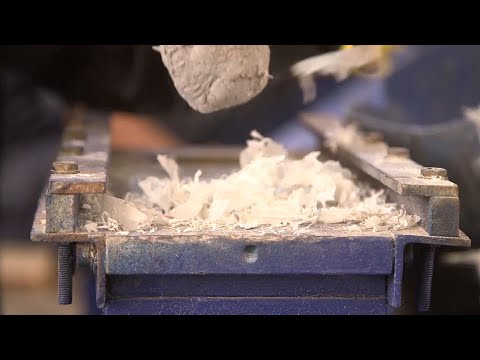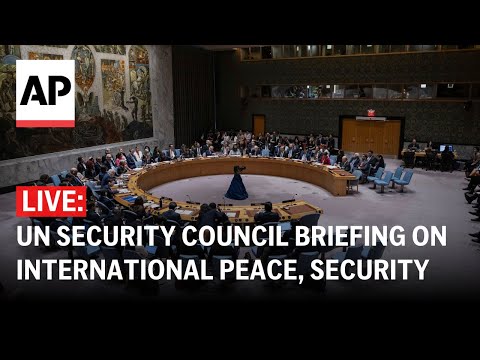(25 Aug 2024)
EGYPT GREEN CONSTRUCTION
SOURCE: ASSOCIATED PRESS
RESTRICTION SUMMARY:
LENGTH: 6:43
ASSOCIATED PRESS
10th of Ramadan City, Al Sharqiyah province, Egypt- 4 August 2024
1. Wide of workers at TileGreen factory
2. Close of shredded plastic bags being pushed inside a machine
3. Various of workers
5. Close of worker extracting composite
6. Close of worker’s face
7. Mid of worker’s hand trimming composite coming out of machine
8. SOUNDBITE (Arabic) Khaled Raafat, co-founder and chief technology officer at TileGreen:
“We invented a technology and an industrial process whereby we transform all forms of plastic wastes, namely those of low value, into building materials. We manufacture a material named polymer aggregate composite, where we mix plastic wastes with natural aggregates like sand and gravel in order to produce a substitute for concrete. We can use this composite to produce multiple products.”
9. Close of bag filled with shredded plastic waste
10. Wide of workers spreading shredded plastic waste on machine
11. Close of machine with plastic waste
12. Mid of worker placing plastic waste in mixer where it is mixed with sand
13. Close of mixer
14. Various of worker at mixer
15. SOUNDBITE (Arabic) Khaled Raafat, co-founder and chief technology officer at TileGreen:
“Egypt produces around 4.5 million tons of plastic waste a year. The recycling rate is somewhere between 10 and 15 percent. This is a good rate compared to recycling rates in other neighbouring countries but it shows that there is a still a huge gap in recycling and that plastic waste ends up reaching undesirable places.”
16. Wide of workers at the production line
17. Mid of workers
18. Close of shredded plastic wastes being pushed inside machine
19. Mid of worker
ASSOCIATED PRESS
Cairo, Egypt – 13 August 2024
20. SOUNDBITE (Arabic) Mohamed El Zayat, adjunct assistant professor of environmental engineering at the American University in Cairo:
“Building and construction is a huge sector and it has a lot of indirect and direct feeding industries. The environmental impact of this sector stems from the manufacturing process of building materials like bricks, cement, steel and others. The manufacturing of these materials produces carbon emissions, which eventually contribute to climate change. For example, the manufacturing of one kilogram of cement produces nearly one kilogram of CO2, which is a greenhouse gas. Hence, we are speaking of an industry that has a terrible impact on the environment.”
ASSOCIATED PRESS
10th of Ramadan City, Al Sharqiyah province, Egypt – 4 August 2024
21. Mid worker handling cement-like composite
22. Mid of composite
23. Close of composite
24. Mid of worker
25. Close of scale
26. Mid of worker weighing composite
27. SOUNDBITE (Arabic) Khaled Raafat, Co-founder and Chief Technology Officer at TileGreen:
“We are currently producing interlocking tiles but our technology can allow us to produce building bricks, floor tiles, pillars, different precast products as well as urban furniture. Our technology can be applied to produce more than 40 products.”
ASSOCIATED PRESS
Sheikh Zayed City, Giza, Egypt – 7 August 2024
28. Wide of SODIC headquarter building
29. Close of SODIC sign
30. Various of Khaled Raafat with Ahmed El-Hawany in office
31. SOUNDBITE (English) Ahmed El-Halawany, SODIC chief development officer:
32. Pan to pathway made with TileGreen interlocking blocs
33. Mid of pathway
34. Mid of interlocking tiles with woman walking
35. Wide of pathway
ASSOCIATED PRESS
Cairo, Egypt- 13 August 2024
Find out more about AP Archive: http://www.aparchive.com/HowWeWork
Twitter: https://twitter.com/AP_Archive
Facebook: https://www.facebook.com/APArchives
Instagram: https://www.instagram.com/APNews/
You can license this story through AP Archive: http://www.aparchive.com/metadata/youtube/3d888195e337418bac5e7d237888230b
Author: AP Archive
Go to Source
News post in August 30, 2024, 3:04 am.
Visit Our Sponsor’s:
News Post In – News





